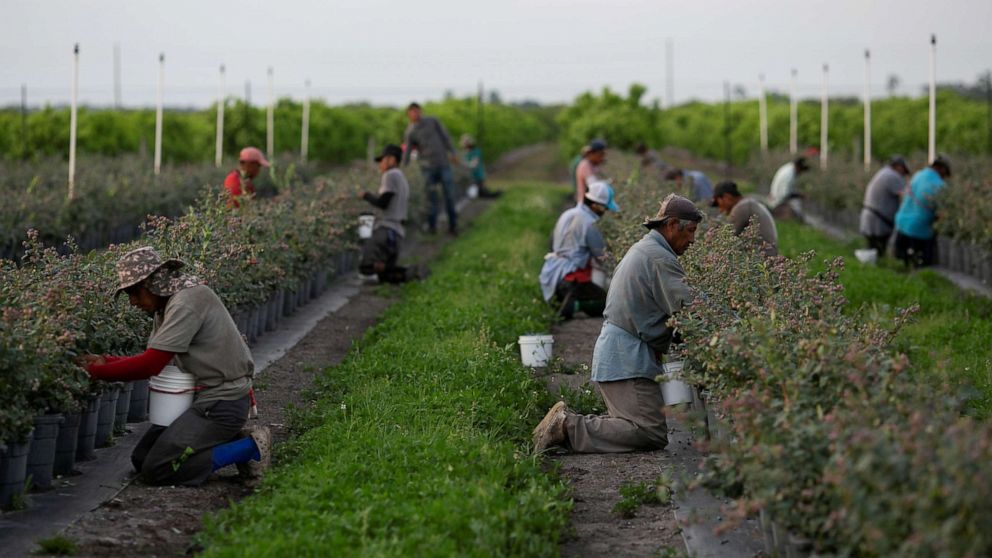Latinos shoulder disproportionate coronavirus cases: CDC data
Under the scorching Florida sun, Adriana Enrique picks fresh fruit and vegetables every day. Bearing the responsibility of being the only provider for her family and being deemed by the federal government as “essential," Enrique is among a demographic that new data suggests is bearing a disproportionate share of coronavirus cases.
“Since the pandemic began, many of the people I work with have tested positive for the virus,” said Enrique, a "Dreamer" protected by the Deferred Action for Childhood Arrivals (DACA) program. “And it’s not only farmworkers, a lot of people in my neighborhood who are Hispanic have also gotten COVID-19.”
The new data, released by the Centers for Disease Control and Prevention (CDC) Wednesday, suggests that Latino Americans across the nation are suffering a disproportionate number of coronavirus cases, surpassing percentages of other minority groups testing positive.
The data on the impact of the coronavirus on ethnic and minority groups is still emerging because states are not yet required to submit that demographic data, though a new measure will require it beginning Aug. 1.
But the current statistics released by the CDC show the percentage of Hispanic/Latino Americans making up coronavirus cases is almost equal to whites -- around 34% -- despite Latinos being a significantly smaller portion of the population.
In Anne Arundel County in Maryland, for example, Hispanic residents account for 38% of coronavirus cases despite making up 8% of the population. In Tennessee, Nashville's Latino population accounts for one-third of COVID-19 cases, but is only 10% of the city's total population.
In Monterey County in California, where more than a quarter of all the cases of COVID-19 have occurred in the past week, 80% of patients identified as Latino or Hispanic.
“Many of my relatives who have agricultural jobs or work in construction have gotten the virus,” said Leticia Morfin, a resident in Monterey County. “They know going out is a risk, but they have bills to pay and children to take care of.”
Tune into ABC at 1 p.m. ET and ABC News Live at 4 p.m. ET every weekday for special coverage of the novel coronavirus with the full ABC News team, including the latest news, context and analysis.
Dr. Teresa Murray Amato, director of emergency medicine at Long Island Jewish Forest Hills in Queens, told ABC News the data released by the CDC isn’t surprising. She said she has seen Latino patients at a much higher rate than others since March.
“Not just were they getting infected, I felt that our Latino and Latina patients were having worse outcomes,” said Amato. “It just seemed like they were really getting hit very very hard, and all the new data does prove that it’s not just anecdotal, but it is actually true that underrepresented minorities people of color are actually having worse outcomes and worse mortality and morbidity from COVID than their white counterparts.”
Amato said one of the main reasons why Latinos are becoming infected and dying at disproportionately high rates is because of the jobs they work in that require them to leave home, without being able to socially distance themselves.
“They are construction workers, farmers, fast food employees,” said Amato. “They do not have the luxury to stay home.”
“You have workers making very little money to continue to make the engines of the nation run but they’re not receiving any protections or benefits,” said Mónica Ramírez, the President of Justice for Migrant Women, an advocacy organization seeking to protect the interests and rights of farm worker women. “Working from home is not an option.”
The Food and Environment Reporting Network, an independent, non-profit news organization, found 2,228 coronavirus cases in farmworkers at 39 farms and production facilities around the country. According to the U.S. Department of Agriculture (USDA), 80% of farm workers identify as Latino/Hispanic.
In a study released by The Journal of the American Medical Association, more than 40% of Latinos in the Baltimore-Washington, D.C. metropolitan region tested positive for COVID-19, a much higher proportion than for any other racial or ethnic group.
The study noted that Latino patients have historically demonstrated lower rates of insurance and health care utilization and that there is decreased opportunity for social distancing because of dense housing and essential worker status.
“In many states, Latinos can’t pay a $1,500 rent, so it’s very common to find a family of four renting one room,” said Alejandra Morales, the founder of Voz Latina, an advocacy organization that provides support to Hispanic families in New Jersey.
“Unfortunately, this is how it is for Latinos. We can’t stay home even though we want to, we can’t ‘social distance,’ we have to get up every day and work to support our families," she said. "And now that comes with a life-threatening risk. ”
ABC News' Soorin Kim, Olivia Rubin and Alexandra Dukakis contributed to this report.
What to know about coronavirus:
- How it started and how to protect yourself: Coronavirus explained
- What to do if you have symptoms: Coronavirus symptoms
- Tracking the spread in the U.S. and worldwide: Coronavirus map




